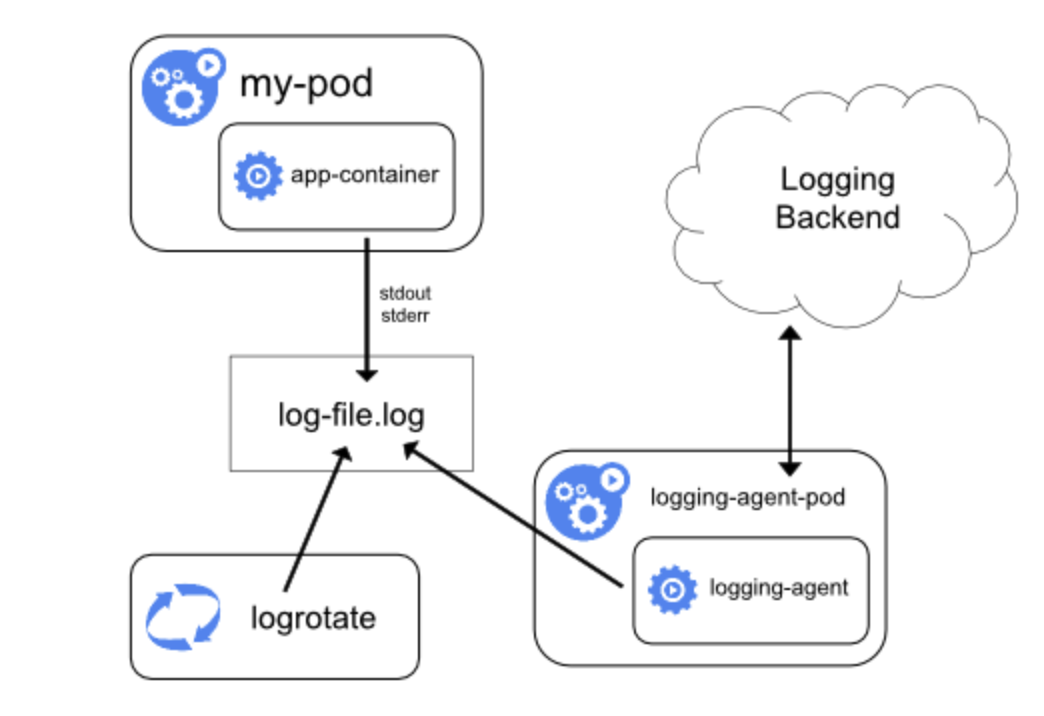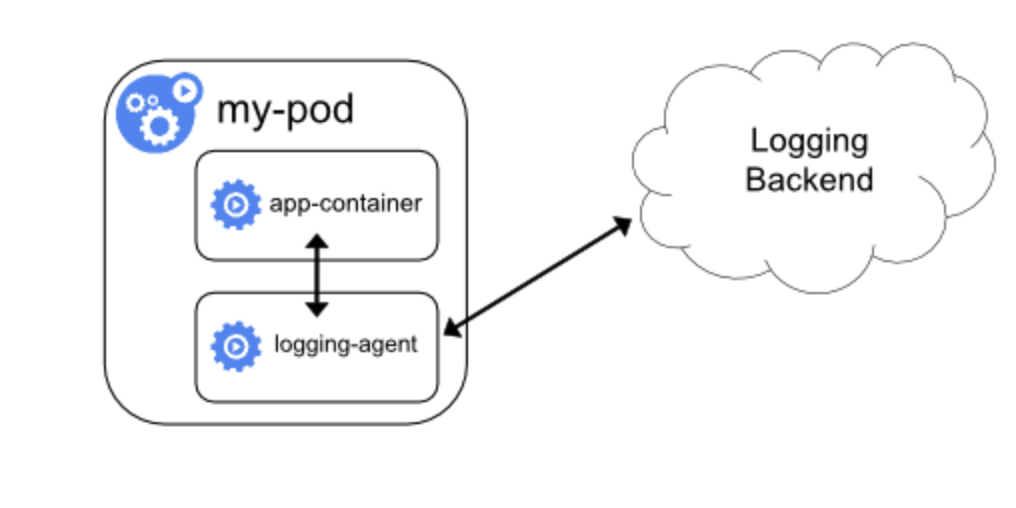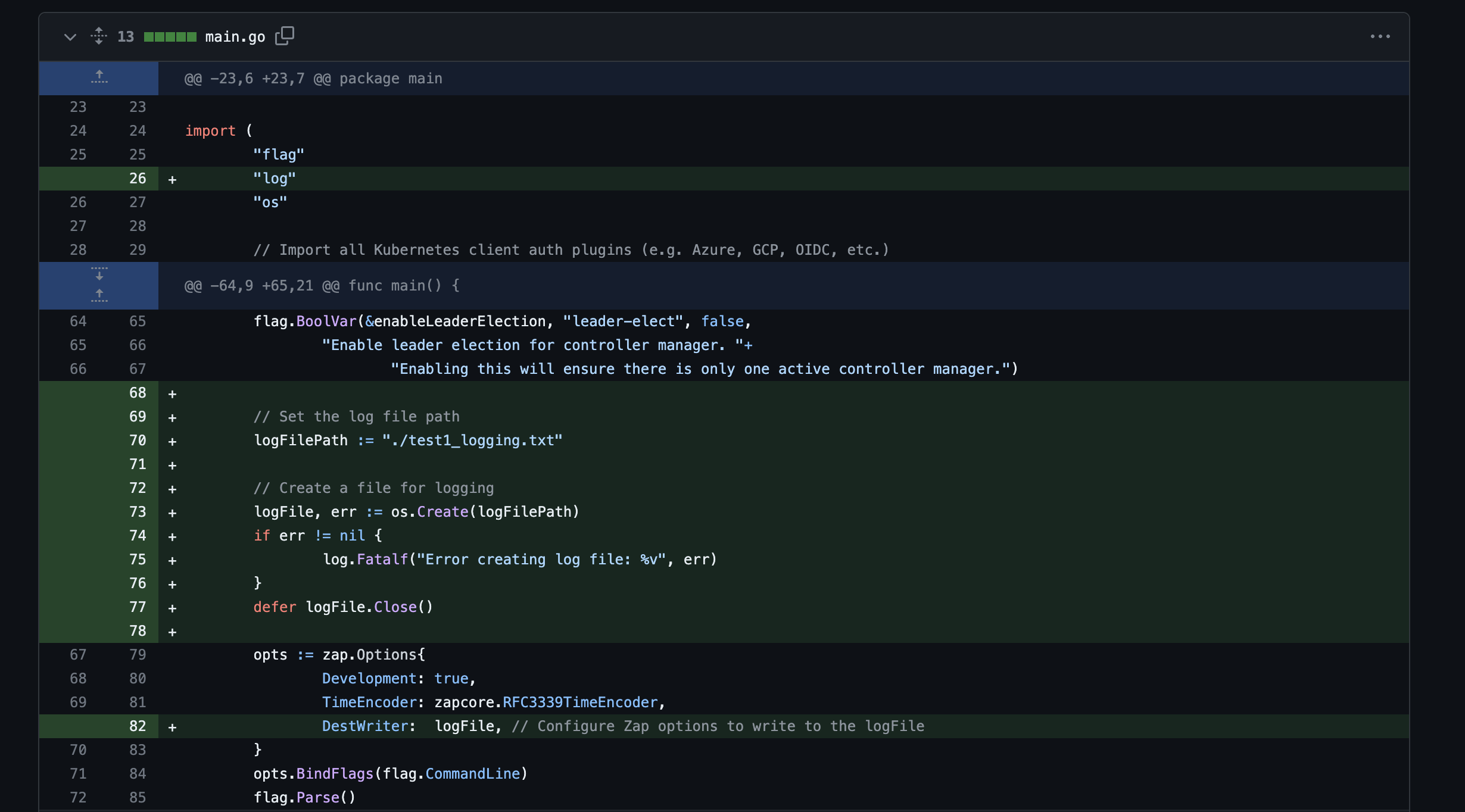CSC/ECE 517 Fall 2023 - NTX-2 Observability and Debuggability: Difference between revisions
No edit summary |
|||
| Line 243: | Line 243: | ||
[[File:Code_Changes.png | 800px]] | [[File:Code_Changes.png | 800px]] | ||
The logs which are saved in the test1_logging.txt file are: | |||
2023-11-15T22:32:37-05:00 INFO controller-runtime.metrics Metrics server is starting to listen {"addr": ":8080"} | |||
2023-11-15T22:32:37-05:00 INFO setup starting manager | |||
2023-11-15T22:32:37-05:00 INFO starting server {"path": "/metrics", "kind": "metrics", "addr": "[::]:8080"} | |||
2023-11-15T22:32:37-05:00 INFO Starting server {"kind": "health probe", "addr": "[::]:8081"} | |||
2023-11-15T22:32:37-05:00 INFO Starting EventSource {"controller": "database", "controllerGroup": "ndb.nutanix.com", "controllerKind": "Database", "source": "kind source: *v1alpha1.Database"} | |||
2023-11-15T22:32:37-05:00 INFO Starting EventSource {"controller": "database", "controllerGroup": "ndb.nutanix.com", "controllerKind": "Database", "source": "kind source: *v1.Service"} | |||
2023-11-15T22:32:37-05:00 INFO Starting EventSource {"controller": "ndbserver", "controllerGroup": "ndb.nutanix.com", "controllerKind": "NDBServer", "source": "kind source: *v1alpha1.NDBServer"} | |||
2023-11-15T22:32:37-05:00 INFO Starting EventSource {"controller": "database", "controllerGroup": "ndb.nutanix.com", "controllerKind": "Database", "source": "kind source: *v1.Endpoints"} | |||
2023-11-15T22:32:37-05:00 INFO Starting Controller {"controller": "database", "controllerGroup": "ndb.nutanix.com", "controllerKind": "Database"} | |||
2023-11-15T22:32:37-05:00 INFO Starting Controller {"controller": "ndbserver", "controllerGroup": "ndb.nutanix.com", "controllerKind": "NDBServer"} | |||
2023-11-15T22:32:37-05:00 INFO Starting workers {"controller": "ndbserver", "controllerGroup": "ndb.nutanix.com", "controllerKind": "NDBServer", "worker count": 1} | |||
2023-11-15T22:32:37-05:00 INFO Starting workers {"controller": "database", "controllerGroup": "ndb.nutanix.com", "controllerKind": "Database", "worker count": 1} | |||
2023-11-15T22:32:52-05:00 INFO Stopping and waiting for non leader election runnables | |||
2023-11-15T22:32:52-05:00 INFO shutting down server {"path": "/metrics", "kind": "metrics", "addr": "[::]:8080"} | |||
2023-11-15T22:32:52-05:00 INFO Stopping and waiting for leader election runnables | |||
2023-11-15T22:32:52-05:00 INFO Shutdown signal received, waiting for all workers to finish {"controller": "database", "controllerGroup": "ndb.nutanix.com", "controllerKind": "Database"} | |||
2023-11-15T22:32:52-05:00 INFO Shutdown signal received, waiting for all workers to finish {"controller": "ndbserver", "controllerGroup": "ndb.nutanix.com", "controllerKind": "NDBServer"} | |||
2023-11-15T22:32:52-05:00 INFO All workers finished {"controller": "database", "controllerGroup": "ndb.nutanix.com", "controllerKind": "Database"} | |||
2023-11-15T22:32:52-05:00 INFO All workers finished {"controller": "ndbserver", "controllerGroup": "ndb.nutanix.com", "controllerKind": "NDBServer"} | |||
2023-11-15T22:32:52-05:00 INFO Stopping and waiting for caches | |||
2023-11-15T22:32:52-05:00 INFO Stopping and waiting for webhooks | |||
2023-11-15T22:32:52-05:00 INFO Wait completed, proceeding to shutdown the manager | |||
==References== | ==References== | ||
Revision as of 03:53, 16 November 2023
Problem Statement
1. Devise a mechanism to export the NDB Operator (controller manager) logs to a logging system - ELK in our case.
2. We don’t want to reinvent the wheel and should focus on existing open source tools which can be used for this purpose.
3. Metrics: Add support to export basic K8s metrics which can be queried/used by tools like Prometheus later.
About Kubernetes
Kubernetes, often abbreviated as K8s, is an open-source container orchestration platform that automates the deployment, scaling, and management of containerized applications. It was originally developed by Google and is now maintained by the Cloud Native Computing Foundation (CNCF). Kubernetes provides a powerful and flexible framework for managing containers, making it easier to deploy and manage complex, distributed applications.
Key Concepts and Components of Kubernetes
1. Containers: Kubernetes is designed to work with containers, which are lightweight, portable, and isolated environments for running applications and their dependencies. Docker is one of the most popular container runtimes used with Kubernetes.
2. Nodes: These are the machines, whether physical or virtual, that run your containerized applications. Nodes can be part of a cluster and are responsible for running containers and providing computing resources.
3. Pods: The smallest deployable units in Kubernetes are pods. A pod can contain one or more containers, which share the same network namespace and storage volumes. Containers within the same pod can communicate with each other using `localhost`.
4. Replica Sets and Deployments: These are controllers that manage the desired number of pod replicas and ensure they are running. They are used for scaling and rolling updates.
5. Services: Kubernetes services define a consistent way to access and expose applications running in pods. They can be used for load balancing, service discovery, and more.
6. Ingress: Ingress controllers and resources provide a way to manage access to services within the cluster from external networks.
7. ConfigMaps and Secrets: These are used to manage configuration data and sensitive information, like API keys or passwords, separately from the application code.
8. Namespaces: Kubernetes supports the concept of namespaces, which allows you to logically partition and isolate resources within a cluster. It's useful for multi-tenancy and organizing applications.
9. Kubelet: This is an agent that runs on each node in the cluster and is responsible for ensuring containers are running in a pod.
10. Master Node: The control plane, which consists of the Kubernetes master components, manages and oversees the cluster. It includes the API server, etcd (a key-value store for cluster data), the scheduler, and the controller manager.
11. kubectl: This is the command-line tool for interacting with a Kubernetes cluster. It allows you to create, modify, and manage resources in the cluster.
Kubernetes is highly extensible and can be integrated with a wide range of tools and services, making it a popular choice for managing containerized applications, microservices, and cloud-native workloads. It abstracts many of the complexities of managing containers and provides a unified platform for automating deployment, scaling, and operations in modern cloud-native environments.
Secret
A Secret is an object containing a small quantity of sensitive data, such as a password, token, or key. This information would typically be placed in a Pod specification or a container image. The use of a Secret allows for the exclusion of confidential data from application code.
Because Secrets can be created independently of the Pods that utilize them, there is a reduced risk of the Secret (and its data) being exposed during the workflow of creating, viewing, and editing Pods. Kubernetes and applications within the cluster can also implement additional precautions when working with Secrets, like avoiding the storage of sensitive data in nonvolatile storage.
Secrets share similarities with ConfigMaps but are specifically designed to store confidential data.
Custom Resource Definition
A custom resource is an object that extends the Kubernetes API or allows us to introduce our own API into a project or a cluster. A custom resource definition (CRD) file defines our own object kinds and lets the API Server handle the entire lifecycle.
Kubernetes Operator
A Kubernetes operator is a specialized method for packaging, deploying, and managing Kubernetes applications. It leverages Kubernetes API and tooling to create, configure, and automate complex application instances on behalf of users. Operators extend Kubernetes controllers and are equipped with domain-specific knowledge to handle the entire application lifecycle. They continuously monitor and maintain applications, and their actions can range from scaling and upgrading to managing various aspects of applications, such as kernel modules.
Operators utilize custom resources (CRs) defined by custom resource definitions (CRDs) to manage applications and components. They watch CR types and translate high-level user directives into low-level actions, adhering to best practices embedded in their logic. These custom resources can be managed through kubectl and included in role-based access control policies.
Operators make it possible to automate tasks that go beyond Kubernetes' built-in automation features, aligning with DevOps and site reliability engineering (SRE) practices. They encapsulate human operational knowledge into software, eliminating manual tasks and are typically created by those with expertise in the specific application's business logic.
The Operator Framework is a set of open-source tools that streamline operator development, offering an Operator SDK for building operators without deep Kubernetes API knowledge, Operator Lifecycle Management for overseeing operator installation and management, and Operator Metering for usage reporting in specialized services.
In summary, Kubernetes operators simplify the management of complex, stateful applications by encoding domain-specific knowledge into Kubernetes extensions, making the processes scalable, repeatable, and standardized. They are valuable for both application developers and infrastructure engineers, streamlining application deployment and management while reducing support burdens.
Nutanix Database Service
Introduction
Nutanix is a hybrid multicloud DBaaS for Microsoft SQL Server, Oracle, PostgreSQL, MongoDB, and MySQL. It efficiently and securely manages hundreds to thousands of databases along with powerful automation for provisioning, scaling, patching, protection, and cloning of database instances. NDB helps customers deliver database as a service (DBaaS) and an easy-to-use self-service database experience on-premises and public cloud to their developers for both new and existing databases.
Benefits
Simplified Database Management and Accelerated Software Development Across Multiple Clouds:
1. Automate laborious database administrative tasks without sacrificing control or flexibility.
2. Streamline database provisioning to make it simple, rapid, and secure, thereby supporting agile application development.
Enhanced Security and Consistency in Database Operations:
1. Automate database administration tasks to ensure the consistent application of operational and security best practices across your entire database fleet.
Expedited Software Development:
1. Empower developers to effortlessly deploy databases with minimal effort, directly from their development environments, facilitating agile software development.
Increased Focus for DBAs on High-Value Activities:
1. By automating routine administrative tasks, Database Administrators (DBAs) can allocate more time to activities of higher value, such as optimizing database performance and delivering new features to developers.
Preserved Control and Maintenance of Database Standards:
1. Select the appropriate operating systems, database versions, and extensions to meet specific application and compliance requirements while retaining control over your database environment.
Features
1. Database lifecycle management: Manage the entire database lifecycle, from provisioning and scaling to patching and cloning, for all your SQL Server, Oracle, PostgreSQL, MySQL, and MongoDB databases.
2. Database management at scale: Manage hundreds to thousands of databases across on-premises, one or more public clouds, and colocation facilities, all from a single API and console.
3. Self-service database provisioning: Enable self-service provisioning for both dev/test and production use via API integration with popular infrastructure management and development tools like Kubernetes and ServiceNow.
4. Database protection and Compliance: Quickly roll out security patches across some or all your databases and restrict access to databases with role-based access controls to ensure compliance.
5. High Availability: Nutanix DBaaS typically includes high availability features to minimize database downtime and ensure continuous access to data.
NDB Architecture
The Nutanix Cloud Platform combines hybrid cloud infrastructure, multicloud management, unified storage, database services, and desktop services to facilitate the operation of any application or workload, regardless of location.
Nutanix provides a comprehensive cloud infrastructure solution, featuring hyper-converged architecture for simplified compute and storage management. This encompasses networking, disaster recovery, security, AI-driven edge computing, private cloud deployment, and MSP services, promoting scalability, high availability, security, and innovation across various IT needs.
Nutanix Cloud Management streamlines the entire application lifecycle with seamless deployment, scaling, monitoring, and optimization, enabling self-service infrastructure provisioning, cost efficiency, and AI-driven insights for agile, secure, and cost-effective cloud management.
Nutanix Unified Storage offers software-defined, scalable storage solutions that cater to enterprise NAS and object workloads for unstructured data, structured data with block storage, and backup storage. It replaces traditional independent storage services and offering a unified control plane.
Nutanix Database Service (NDB) can easily manage databases across multiple locations both on-premises and in the cloud with Nutanix Cloud Clusters (NC2) on Amazon Web Services (AWS). In a multi cluster NDB environment, the NDB management plane requires one NDB management agent VM in each Nutanix cluster it manages.
Logging Architecture
The logs are very helpful for tracking cluster activity and troubleshooting issues. The majority of contemporary apps contain some sort of logging system. Container engines are also built to accommodate logging. Writing to standard error and output streams is the most popular and simplest logging technique for containerized applications.
However, most of the time a complete logging solution requires more than the basic capability offered by a container engine or runtime. For instance, in the event that a node fails, a pod is removed, or a container crashes, we might wish to see the logs for our application.
Logs in a cluster should be stored and managed independently of nodes, pods, or containers. We refer to this idea as cluster-level logging. Cluster-level logging architectures require a separate backend to store, analyze, and query logs.
Cluster-level logging architectures
While Kubernetes does not provide a native solution for cluster-level logging, there are several common approaches we can consider. Here are some options:
1. Push logs directly to a backend from within an application.
2. Use a node-level logging agent that runs on every node.
3. Include a dedicated sidecar container for logging in an application pod.
1. Exposing logs directly from the application
Cluster-logging that exposes or pushes logs directly from every application is outside the scope of our considerations. The main reason driving the eviction of this option is the Single-responsibility principle. Modifying the application code to handle logging to a backend store violates this principle. It also hampers scalability.
2. Using a node logging agent
By installing a node-level logging agent on every node, we can implement cluster-level logging. An specialized tool called a logging agent is used to push or expose logs to a backend. Typically, a container with access to a directory containing log files from each application container on that node serves as the logging agent.
It is advised to run the logging agent as a DaemonSet since it needs to operate on each node. Node-level logging doesn't require any modifications to the node's running applications and only generates one agent per node.
Containers write to stdout and stderr, but with no agreed format. These logs are gathered by a node-level agent and forwarded for aggregation.
3. Using a sidecar container with the logging agent
There are 2 ways in which a sidecar container can be used:
a. The sidecar container streams application logs to its own stdout.
b.The sidecar container runs a logging agent, which is configured to pick up logs from an application container.
3.a. Streaming sidecar container
This approach allows us to separate several log streams from different parts of our application, some of which can lack support for writing to stdout or stderr. The logic behind redirecting logs is minimal, so it's not a significant overhead. But we haven’t found the benefit of using this approach as it increases complexity by adding more interaction surfaces.
3.b. Sidecar container with a logging agent
We can create a sidecar container with a different logging agent that we have configured specifically to run with our application if the node-level logging agent isn't flexible enough.
When a logging agent is used in a sidecar container, a lot of resources may be used. Furthermore, since those logs are independent of the kubelet, we will not be able to access them using kubectl logs.
Which one to choose?
Here's a table outlining the pros and cons of the four different logging architectures discussed:
| Logging Architecture | Pros | Cons |
|---|---|---|
| Exposing Logs Directly from Application | 1. Allow us to have fine-grained control over the log generation and transmission process.
2. Achieves complex log handling for very specific logging needs
|
1. Logs may not be centralized and may be scattered across nodes.
2. No native support for log collection and analysis. 3. Complex and custom implementation required for log handling. 4. Not recommended by Kubernetes. |
| Node-level Logging Agent | 1. Centralized log collection from all nodes.
2. Allows for easy log aggregation and analysis. 3.Minimal changes to applications running on nodes. |
1. Requires a logging agent to run on every node, which may consume additional resources.
2. Additional overhead for log forwarding and aggregation. 3. Logs may be in different formats, requiring parsing for analysis.
|
| Sidecar Container with Streaming | 1. Separation of different log streams for applications.
2. Leverages kubelet and builtin tools for log access. 3. Simplifies log rotation and retention policies. |
1. Potential increase in storage usage if applications write to files.
2. Not recommended for apps with low CPU and memory usage. 3. May not be suitable for applications with diverse log formats. |
| Sidecar Container with Logging Agent | 1. Provides flexibility for custom log collection and processing.
2. Tailored log collection for specific applications. 3. Enables advanced log processing and routing options. |
1. Increased resource consumption due to additional container.
2. Logs in sidecar containers are not accessible using kubectl logs.
|
Phase 2: Code Changes
We went ahead with the approach to write the log statements generated to a file. The code changes were made in main.go file of the repository. The logs have been written in a file called test1_logging.txt, which is a text file.
Here are the code changes:
The logs which are saved in the test1_logging.txt file are:
2023-11-15T22:32:37-05:00 INFO controller-runtime.metrics Metrics server is starting to listen {"addr": ":8080"}
2023-11-15T22:32:37-05:00 INFO setup starting manager
2023-11-15T22:32:37-05:00 INFO starting server {"path": "/metrics", "kind": "metrics", "addr": "[::]:8080"}
2023-11-15T22:32:37-05:00 INFO Starting server {"kind": "health probe", "addr": "[::]:8081"}
2023-11-15T22:32:37-05:00 INFO Starting EventSource {"controller": "database", "controllerGroup": "ndb.nutanix.com", "controllerKind": "Database", "source": "kind source: *v1alpha1.Database"}
2023-11-15T22:32:37-05:00 INFO Starting EventSource {"controller": "database", "controllerGroup": "ndb.nutanix.com", "controllerKind": "Database", "source": "kind source: *v1.Service"}
2023-11-15T22:32:37-05:00 INFO Starting EventSource {"controller": "ndbserver", "controllerGroup": "ndb.nutanix.com", "controllerKind": "NDBServer", "source": "kind source: *v1alpha1.NDBServer"}
2023-11-15T22:32:37-05:00 INFO Starting EventSource {"controller": "database", "controllerGroup": "ndb.nutanix.com", "controllerKind": "Database", "source": "kind source: *v1.Endpoints"}
2023-11-15T22:32:37-05:00 INFO Starting Controller {"controller": "database", "controllerGroup": "ndb.nutanix.com", "controllerKind": "Database"}
2023-11-15T22:32:37-05:00 INFO Starting Controller {"controller": "ndbserver", "controllerGroup": "ndb.nutanix.com", "controllerKind": "NDBServer"}
2023-11-15T22:32:37-05:00 INFO Starting workers {"controller": "ndbserver", "controllerGroup": "ndb.nutanix.com", "controllerKind": "NDBServer", "worker count": 1}
2023-11-15T22:32:37-05:00 INFO Starting workers {"controller": "database", "controllerGroup": "ndb.nutanix.com", "controllerKind": "Database", "worker count": 1}
2023-11-15T22:32:52-05:00 INFO Stopping and waiting for non leader election runnables
2023-11-15T22:32:52-05:00 INFO shutting down server {"path": "/metrics", "kind": "metrics", "addr": "[::]:8080"}
2023-11-15T22:32:52-05:00 INFO Stopping and waiting for leader election runnables
2023-11-15T22:32:52-05:00 INFO Shutdown signal received, waiting for all workers to finish {"controller": "database", "controllerGroup": "ndb.nutanix.com", "controllerKind": "Database"}
2023-11-15T22:32:52-05:00 INFO Shutdown signal received, waiting for all workers to finish {"controller": "ndbserver", "controllerGroup": "ndb.nutanix.com", "controllerKind": "NDBServer"}
2023-11-15T22:32:52-05:00 INFO All workers finished {"controller": "database", "controllerGroup": "ndb.nutanix.com", "controllerKind": "Database"}
2023-11-15T22:32:52-05:00 INFO All workers finished {"controller": "ndbserver", "controllerGroup": "ndb.nutanix.com", "controllerKind": "NDBServer"}
2023-11-15T22:32:52-05:00 INFO Stopping and waiting for caches
2023-11-15T22:32:52-05:00 INFO Stopping and waiting for webhooks
2023-11-15T22:32:52-05:00 INFO Wait completed, proceeding to shutdown the manager
References
Nutanix website[1]
Kubernetes website for logging documentation[2]
Relevant Links
Github repository: https://github.com/ksjavali/ndb-operator
Team
Mentor
Nandini Mundra
Student Team
Kritika Javali (ksjavali@ncsu.edu)
Rahul Rajpurohit (rrajpu@ncsu.edu)
Sri Haritha Chalichalam (schalic@ncsu.edu)





